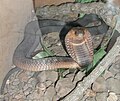Reptile
| Reptiles Temporal range:Pennsylvanian–present,312–0 mya
| |
|---|---|

| |
| Clockwise from above left:Green sea turtle(Chelonia mydas),Tuatara(Sphenodon punctatus),Nile crocodile(Crocodylus niloticus), andSinai agama(Pseudotrapelus sinaitus) | |
| Scientific classification | |
| Domain: | Eukaryota |
| Kingdom: | Animalia |
| Phylum: | Chordata |
| Clade: | Sauropsida |
| Class: | Reptilia Laurenti,1768 |
| Living groups | |
Seetextfor extinct groups. | |

| |
| Global reptile distribution (excluding birds) | |
Reptileis the common name for one of the main groups of landvertebrates.It is not used so much by biologists, who use more accurate terms.
The name "reptile" comes fromLatinand means "one who creeps". All living reptile species arecold blooded,have scalyskin,and laycleidoic eggs.[1][2]They excreteuric acid(instead ofurea), and have acloaca.A cloaca is a shared opening for theanus,urinary tract and reproductive ducts. Reptiles also share an arrangement of theheartand major blood vessels which is different from that of mammals.[3]Birds have all of these features.
Many important groups of reptiles are nowextinct,for example themosasaurs.We used to say thedinosaurswere extinct, but they survive in the form of their feathered descendants (birds). Ancient reptiles that do survive include theturtles,thecrocodilesand theTuatara,the lone survivor of its group. The great majority of present-day reptiles aresnakesandlizards.
The study of living reptiles is calledherpetology.
Birds in relation to reptiles
[change|change source]Some reptiles are more closely related tobirdsthan they are to other reptiles. Crocodiles are more closely related to birds than they are to lizards.Theropoddinosaursare even more closely related, because birds evolved from them.
Cladisticwriters prefer to put the birds (over 10,000 species) with what people usually call reptiles.[4][5][6](seeSauropsida)
Taxonomy
[change|change source]Reptilia is anevolutionary graderather than aclade.The main reason is that the term 'reptile' does not include birds, the descendents oftheropoddinosaurs.Another reason is that the word 'reptile' is misleading because many extinct types were very different from living reptiles.
So instead of Reptilia as a taxonomic class, today many experts use ClassSauropsida(which includes all reptiles and birds, living and extinct). ClassSynapsidaincludes mammals and all their forebears.Reptileis still the usualinformalterm to describe livingsnakesandlizards.Mammals are a genuine clade, and so Mammalia is still the taxonomic term.
Since reptiles are notmonophyletic,reclassifying them is one of the key aims of researchers.[4][7][8]Some taxonomists, such as Benton,[9]make Sauropsida and Synapsida class-leveltaxa.The two groups split in theCarboniferous,from stem-groupAmniotes(the earlytetrapods,which laidcleidoic eggs).
Eye feature
[change|change source]Amembraneforms an innereyelidin reptiles and birds. Whitish or translucent, it can be drawn across the eye to protect it from dust and keep it moist. It is called thenictitating membrane.
Size
[change|change source]Reptiles can live in large and small sizes. Their land sizes can be both bigger and smaller than mammals.Titanosaurswere the largest land reptiles, and the smallest land reptile is achameleon13.5mm long.[10]
Living reptiles
[change|change source]- Reptiles (living groups only)
- OrderCrocodilia(crocodiles,gavials,caimans,andalligators): 23 species
- OrderSphenodontia(TuatarafromNew Zealand): 2 species
- OrderSquamata(lizards,snakes,andamphisbaenids( "worm-lizards" ): about 7,000 species.
- OrderTestudines(turtles,tortoises,andterrapins): approximately 300 species
-
Chameleons,a lizard
-
Komodo dragon,sleeping. Largest livinglizard
References
[change|change source]- ↑Some give birth to live young, with the cleidoic eggs developing internally.
- ↑2008. "Squamata Suborder: Serpentes". The University of Georgia Museum of Natural History.[1]Archived2010-06-13 at theWayback Machine
- ↑Goodrich E.S. 1930.Studies on the structure and development of vertebrates.Macmillan, London.
- ↑4.04.1Gauthier J.A., Kluge A.G & Rowe T. 1988. The early evolution of the Amniota. pp103–155 in Michael J. Benton (ed)The phylogeny and classification of the tetrapods,Volume 1: Amphibians, Reptiles, Birds.Systematics Association,Special vol 35A. Clarendon Press, Oxford.
- ↑Laurin, Michel; Reisz, Robert R. (1995)."A reevaluation of early amniote phylogeny"(PDF).Zoological Journal of the Linnean Society.113(2): 165–223.doi:10.1111/j.1096-3642.1995.tb00932.x.
- ↑Modesto, S.P. (1999). "Observations of the structure of the Early Permian reptileStereosternum tumidumCope ".Palaeontologia Africana.35:7–19.
- ↑Gauthier J.A. 1994. The diversification of the amniotes. In D.R. Prothero and R.M. Schoch (eds)Major features of vertebrate evolution.129-159. Knoxville, Tennessee: The Paleontological Society.
- ↑Laurin M. & Gauthier J.A. 1996.Amniota, Mammals, reptiles (turtles, lizards, Sphenodon, crocodiles, birds) and their extinct relatives.Version 01 January 1996. The Tree of Life Web Project.
- ↑Benton, Michael J. 2004.Vertebrate Paleontology.3rd ed, Blackwell, Oxford.ISBN0-632-05637-1.
- ↑'Smallest reptile on earth' discovered in Madagascar.BBC News[2].
| Vertebrates |
|---|
| Amphibian•Bird•Fish•Mammal•Reptile |






